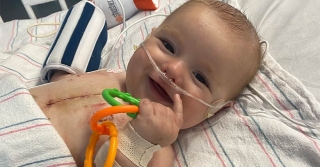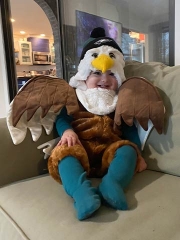A Lifesaving Call: Ellis’ Journey with Single Ventricle Heart Disease
Published on
Published on
When Kerry was pregnant with her second child, her doctor said, “Honestly, our bodies are so complex that I’m actually more surprised when hearts do form correctly.” This made Kerry feel better – because at her 20-week ultrasound anatomy scan, her doctors found something that didn’t look right.
 Before he was even born, Ellis became a well-known name around the Cardiac Center at Children’s Hospital of Philadelphia (CHOP). He was diagnosed with single ventricle heart disease at CHOP’s Specialty Care and Surgery Center in Voorhees, New Jersey and referred to the Fetal Heart Program. Kerry gave birth in the Center for Fetal Diagnosis and Treatment’s Garbose Family Special Delivery Unit, the world’s first birth facility in a pediatric hospital specifically designed for healthy mothers carrying babies with known birth defects.
Before he was even born, Ellis became a well-known name around the Cardiac Center at Children’s Hospital of Philadelphia (CHOP). He was diagnosed with single ventricle heart disease at CHOP’s Specialty Care and Surgery Center in Voorhees, New Jersey and referred to the Fetal Heart Program. Kerry gave birth in the Center for Fetal Diagnosis and Treatment’s Garbose Family Special Delivery Unit, the world’s first birth facility in a pediatric hospital specifically designed for healthy mothers carrying babies with known birth defects.
“Ellis is my second-born, which meant I thought I knew what I was in for this time around, but it’s almost as if I had never been pregnant before,” says Kerry. “Everything was new, and it was terrifying.” The CHOP care team walked her through what to expect.
“They were there to monitor mine and Ellis’ health,” she says, “But they were also there to talk me off a ledge every time I felt too scared or overwhelmed. That made it a lot easier.”
 Ellis’ combination of complex congenital heart defects resulted in one instead of two functional pumping chambers.These defects included D-transposition of the great arteries (two main arteries connected to the wrong chambers of the heart; a large ventricular septal defect (or hole in the opening between the heart’s lower chambers); a small left ventricular outflow track (the portion of the ventricle through which blood passes to enter the arteries); and a small main pulmonary artery.
Ellis’ combination of complex congenital heart defects resulted in one instead of two functional pumping chambers.These defects included D-transposition of the great arteries (two main arteries connected to the wrong chambers of the heart; a large ventricular septal defect (or hole in the opening between the heart’s lower chambers); a small left ventricular outflow track (the portion of the ventricle through which blood passes to enter the arteries); and a small main pulmonary artery.
At 5 days old, Ellis underwent a cardiac catheterization with Michael O’Byrne, MD, MSCE. Dr. O’Byrne placed a stent (a metal mesh scaffold) in Ellis’ patent ductus arteriosus (an opening between the two major blood vessels leading from the heart) which would allow enough blood to flow to Ellis’ lungs and keep his body oxygenated until his next procedure. This was the first of three procedures that would redirect blood flow in Ellis’ heart using only one ventricle.
Following Ellis’ discharge five days later, he entered CHOP’s Infant Single Ventricle Monitoring and Management Program (ISVMP), which provides specialized care for such fragile infants during the highest risk period between the first and second heart procedures for children with single ventricle heart defects. This program monitors patients and families closely to prevent life-threatening events and maximize growth and development in preparation for a child’s second operation.
Led by Therese Giglia, MD, and Alyson Stagg, MSN, CRNP, this multidisciplinary team consists of nine cardiologists and nutritionists who collaborate to create, implement, innovate and continually reassess standardized protocols, as well as incorporate caregivers into the healthcare team through necessary education and ongoing support. In an effort to create a medical home and ease the burden of transportation for these medically complex patients and their families, a hybrid care model using telemedicine was developed in 2019 under the direction of Tamar Preminger, MD. Telemedicine visits — including, since 2021, the additional use of Eko digital stethoscopes — allow the care team to quickly identify and manage any clinical concerns, while also preventing unnecessary visits to the Emergency Department.
“This has been an amazing resource,” says Kerry. “There were constant follow-ups and regularly scheduled video visits. The team taught me to keep a close eye on Ellis’ stats. I took his pulse-ox to measure the oxygen in his body twice a day and monitored his weight daily. I knew we’d catch any changes almost immediately and be ready to act if something did go wrong. There was nothing they took lightly.”
The program monitored Ellis’ health, but it also became an important source of support for Kerry. “Ellis was vulnerable in that period between heart surgeries,” she says. “It was really scary. I remember seeing changes in his stats and panicking, and every time, I had someone to call who took it seriously, who followed up and made sure he was okay.”
 It was during one of these routinely scheduled telemedicine visits that Ellis was found to have a concerningly low level of oxygen, just hours after Kerry had checked Ellis’ oxygen and found it to be within the acceptable range. The ISVMP team listened to his heart using the Eko digital stethoscope and found that his heart murmur was quieter than it had been at his previous telemedicine visit. Given these new findings, Ellis was immediately admitted to the hospital, where testing confirmed the ISVMP team’s suspicions: Ellis’ stent was narrowing, and he needed urgent surgery.
It was during one of these routinely scheduled telemedicine visits that Ellis was found to have a concerningly low level of oxygen, just hours after Kerry had checked Ellis’ oxygen and found it to be within the acceptable range. The ISVMP team listened to his heart using the Eko digital stethoscope and found that his heart murmur was quieter than it had been at his previous telemedicine visit. Given these new findings, Ellis was immediately admitted to the hospital, where testing confirmed the ISVMP team’s suspicions: Ellis’ stent was narrowing, and he needed urgent surgery.
For this surgery, the hardest part was handing Ellis off at the door, Kerry says – but it was a little easier knowing she was putting him in good hands.
Stephanie Fuller, MD, performed urgent surgery and found that Ellis’ patent ductus arteriosus stent was almost entirely obstructed. She reconstructed Ellis’ heart using a bidirectional Glenn shunt, which redirects the blood flow from the veins of the upper body directly to the lungs.
Ellis was discharged seven days later. Now graduated from the single ventricle program, he continues to receive follow up care through CHOP’s Specialty Care Center at Virtua and takes medication daily. At his most recent visit, Kerry reports Ellis was “thriving.”
Ellis will have to undergo another heart operation between the ages of 2 and 3 – and his cardiac team will continue to monitor him.
“Until then, I feel like I’m prepared to care for Ellis in a way I may not have been without this program,” says Kerry. “We have the care we need, but it’s that extra layer of knowing we have the resources we need so close to us. It makes such a difficult situation feel manageable, and with something like this – that’s everything."